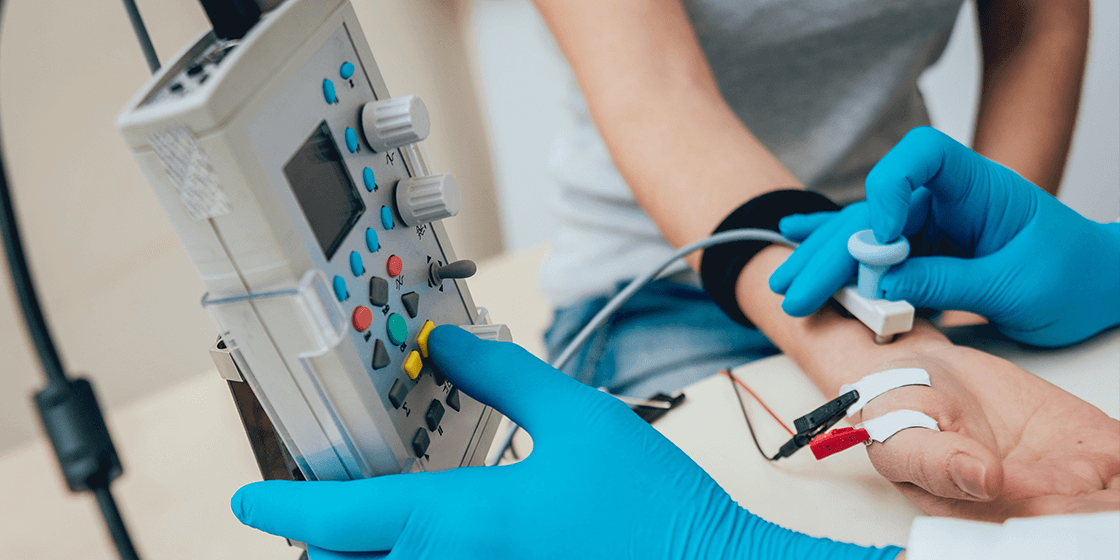Nerve conduction studies measure the strength and speed of nerves signals that deliver messages from the body to the brain. When a nerve goes even a little bit haywire, pain is the typical result. Because your body is so rich in nerves, finding the culprit of your pain can be difficult. Nerve conduction studies allow your doctor to do exactly this. Using electrodes and a low-grade current, your provider can locate the source of your pain and develop a suitable treatment plan.
Why are spinal nerves so important—and easily damaged?
Your Central Nervous System (CNS) plays a crucial role in sustaining a healthy body and an active life.
To put it one way, your central nervous system—composed of the brain and spinal cord—acts as your body’s command center. It’s the principal source for much of your body’s movement and function. Walking, digestion, heartbeat, and blood pressure are all controlled and maintained by the brain. Even our endocrine system, which controls organs such as the thyroid, pancreas, and adrenals, are also monitored by this central processor of the brain.
Messages don’t end at the spinal cord and magically make their way to the muscles and organs. The brain needs a way to send messages through a landline of nerves. In short, the brain could not be effective without its counterpart: the Peripheral Nervous System. Without this partner in crime, the brain would not be able to communicate with muscles and organs in the rest of the body.
Direct electrical messages travel from the brain, through the central spinal cord, and out to the peripheral nerves, across all corners of the body. At the same time, sensory input in the form of temperature, levels of pain, and sensation travels to the brain from the peripheral nerves. And, when we say all corners of the body, we really mean all.
There are more than 46 miles of nerves in your body, and each inch plays an important role in keeping you going. When something happens to these nerves, such as compression, blockage, or negative effects from an infection or disease, these messages can be slowed down or blocked altogether. This can result in muscular soreness, tingling, numbness, and difficulty with movement. At times, if the blockage or damage is severe enough, muscular movement can halt altogether.With 46 miles of nerves in the body, there’s a lot of room for something to go wrong. Spinal nerves are so easily damaged partially because of their sheer abundance in the body.
What can I expect from my Nerve Conduction Study? And, will it hurt?
Because there are so many nerves in the body, determining which group of nerves causes these symptoms can be a challenge. Thankfully, scientists have developed an effective and minimally invasive test to pinpoint the malfunctioning nerve and determine the extent of the damage. If you are suffering from damaged nerves or difficult and painful movement, a noninvasive Nerve Conduction Study may be able to help you.
A Nerve Conduction Study (NCS), also referred to as a Nerve Velocity Test (NVT), will assess the ability of specific nerves to transmit messages to the surrounding muscles. NCS can be used to assist in diagnosing and treating a number of nerve conditions, including: Carpal Tunnel Syndrome, Sciatica Nerve Pain, the symptoms of Guillain-Barre Syndrome, the effects of a bulging or herniated disc, or the neuropathy associated with diabetes or other diseases.If you are deemed a candidate for a Nerve Conduction Study, this simple procedure will be carried out through the following steps:
- Preparation for the study is minimal. The main steps to follow will include pausing the use of lotions or oils a few days before the study and monitoring your body temperature. Normal body temperature is important for proper nerve conduction.
- Generally, there is no fasting needed for a NCS. Also, it is best to wear clothes that allow easy access to the nerves that are to be tested. If needed, a gown will be supplied by your healthcare provider.
- The test is typically administered by a neurologist, who may also utilize the skills of a technologist. These individuals will make sure to answer any of your questions before the test.
- The targeted nerve to be studied will be located by the test administrator. Electrodes will be placed on the skin above the nerve to be studied. If the nerve and subsequent muscles are nestled deep within the body under many layers of tissue, needles may be used to access the nerve.
- A slight and painless electrical current will be passed through one electrode. The the current will be measured through its speed and strength as it reaches the electrode further down on the targeted nerve. This current will be recorded and reported through the use of a computer and specialized software.
- There are few, if any, negative side effects of this study. Most patients report no pain with only a slight discomfort when the electrical current is applied.
The information that is collected from this quick and noninvasive procedure can steer the course of your entire treatment. Your specialist will analyze the speed of the current as well as its strength upon hitting the second electrode. From this information, your doctor will be able to determine the location of the problematic nerve and its conduction quality. This knowledge can help you and your physician map out a treatment pain to achieve maximum relief and to restore muscular function.
At The Advanced Spine Center, our spine specialists are experts in conducting Nerve Conduction Studies and electromyograms. To schedule an appointment with one of our fellowship-trained doctors, please contact The Advanced Spine Center at 973-791-4101.
